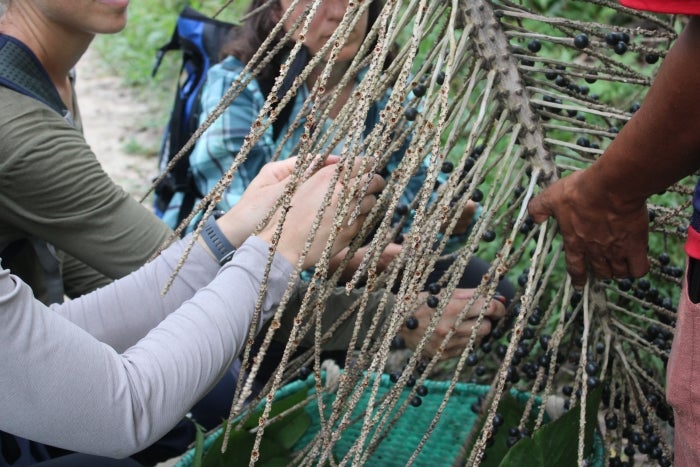ASU researcher studies world's tallest palm trees in her native Colombia

Wax palm trees, endemic to the Andes Cordilleras region of Colombia, are the world's tallest palm trees. Photo courtesy of iStock/Getty Images
Editor's note: This is the third in a five-part series about ASU faculty conducting summer research abroad. Read about carbon collection in the Namib Desert; a pilot program to address HIV care in Uganda; and whiptail lizard research in Mexico.
Colombia is one of the most biodiverse nations on Earth — with everything from lush tropical rainforests to sweeping savannahs and foggy cloud forests.
The South American country has one of the highest numbers of plant species in the world (about 40,000 different plants compared with the U.S.’ 17,000) and more than 200 types of palm trees.
It is where Arizona State University's María José Sanín grew up and where she returned this summer for her latest research project.
“I’ve always wanted to understand which factors have contributed to these levels of plant biodiversity,” says the ASU senior global futures scientist. “Is it geological history? Is it land use dynamics or species interactions? There is no single answer.”
Sanín is finding some insights in the cloud forests of the northern Andes, the highest mountain range outside Asia, where the towering wax palm trees make their home. She has been studying Colombia’s national tree for more than 15 years.
ASU News caught up with Sanín, an assistant professor in the School of Mathematical and Natural Sciences, whose ongoing palm research continues in Colombia this summer.
Question: How do you explain your research in Colombia?
Answer: My research focuses on describing what biodiversity looks like in terms of what we find and where we find it, and which factors have been most relevant in the evolution of certain groups of plants.
Most of my research has focused on the palm family. Palms are very diverse in the tropics. They are also abundant in the different ecosystems of the tropics and heavily used by humans.
This summer, I am taking leaf, root and fruit samples that my group will sequence to understand the effects of river drainage evolution and human use on selected species of palms.
Q: What type of palm trees are you concentrating on?
A: Wax palms are the focus of my research. I have been studying them since 2007.
They are fascinating plants, holding several records, including tallest palms in the world and palms that grow at the highest elevations on mountains.
They are endemic to the region where I grew up, meaning they exist in this region and nowhere else in the world. Because their evolution is so tightly linked to the formation of the Andes Cordilleras — the chain of mountain ranges on the west edge of South America — I’ve worked with geologists to understand the shared history between mountain and wax palm evolution. Tropical Andean volcanoes have also played an important role in wax palm dispersal.
Through the years, I’ve carried out research in many different wild populations of wax palms, having to witness their conservation challenges.
We’ve done work to explain which factors contribute to their population declines and what we should do to guarantee their survival. This has meant working with different sectors of society, from landowners to conservation NGOs to politicians and journalists. It’s been fascinating to work together to make scientific results a ready asset for people.
Q: What is contributing to their decline? And what does that decline mean for the area?
A: Habitat loss. These palms need forest cover to survive as seedlings and juveniles. Thus, although some old adults remain on deforested landscapes, once these old adults die of age, they will not be replaced by younger palms because they can hardly survive outside of forests. Andean mountain cloud forests, where these palms live, have been severely reduced in extension and integrity.
Q: How would you describe the place where you are working today?
A: I am now in the cloud forests of the northern Andes, surrounded by many kilometers of spreading Cordilleras. I am standing at the rim of a canyon.
This morning, as most mornings, clouds slowly crept up the canyon walls and rolled over our heads. These ecosystems are most often moist, either because of rain or mist or low clouds. Plants access all these sources of water and can’t tolerate drought. Forests here are highly structured, with many towering layers of herbs, small trees, tall trees and epiphytes (plants like moss). Soils are covered by many layers of plant litter and it is rare to see bare soil.
Q: How did you become interested in this type of work?
A: I’ve always loved nature and plants. I partly grew up in the countryside, on a farm where there were fragments of native cloud forest, but also many fruit trees and animals and numerous small creeks where we used to play as kids.
I became interested in plant evolution as an undergraduate when I worked with a piperaceae (pepper family) plant specialist who introduced me to the endless ecological strategies and forms of plants from an evolutionary perspective in deep time — billions of years of the Earth’s history.
I later worked under the supervision of Gloria Galeano, a famous Colombian botanist who dedicated her life to studying palm trees. She gifted me with the fascinating world of palms and their intricate links to human, rural communities.
Q: What do you find the most fascinating about this work?
A: Plants are a constant reminder that a lot can be done with a little amount of resources and not even moving. They are a compelling example of intelligence and creativity. Most importantly, they are the fundamental blocks of ecosystems, producing energy for all elements along food chains. I am convinced that the more we focus on their ecology and function, the more prepared we will be to develop and sustain healthy and biodiverse systems.
More Science and technology

Breakthrough copper alloy achieves unprecedented high-temperature performance
A team of researchers from Arizona State University, the U.S. Army Research Laboratory, Lehigh University and Louisiana State University has developed a groundbreaking high-temperature copper alloy…

4 ASU researchers named senior members of the National Academy of Inventors
The National Academy of Inventors recently named four Arizona State University researchers as senior members to the prestigious organization.Professor Qiang Chen and associate professors Matthew…

Transforming Arizona’s highways for a smoother drive
Imagine you’re driving down a smooth stretch of road. Your tires have firm traction. There are no potholes you need to swerve to avoid. Your suspension feels responsive. You’re relaxed and focused on…





